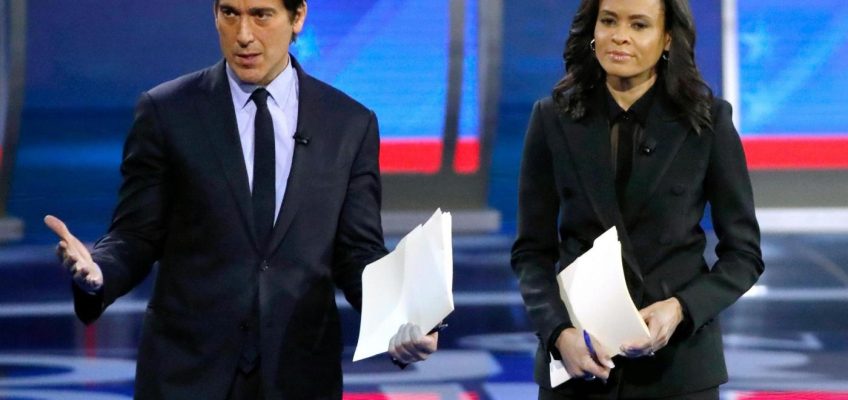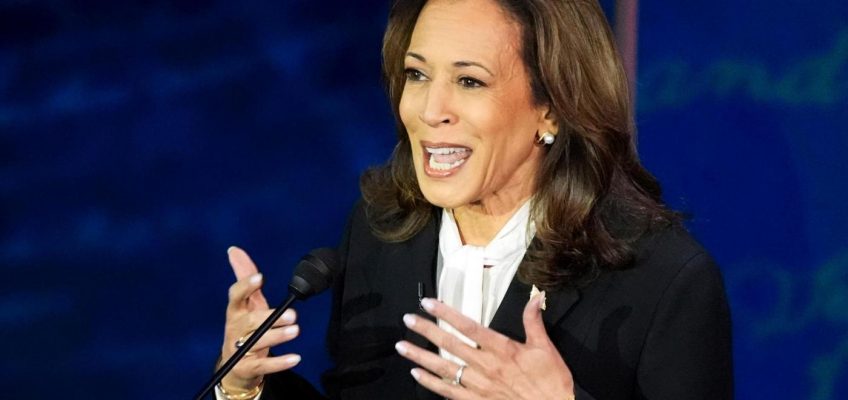By DAVID BAUDER Associated Press
The ABC News moderators were great. No, actually they were a “disgraceful failure.” They cut off Kamala Harris too much. No, actually they corrected Donald Trump unfairly.
Such is the contentious tenor of the times in 2024’s campaign season. And so it went Tuesday night at Trump’s and Harris’ first — and possibly only — debate.
In an illustration of how difficult it is to conduct a presidential debate in a polarized country, ABC News moderators David Muir and Linsey Davis fact-checked and corrected Trump four times Tuesday and were attacked angrily by the former president and his supporters. The moderators asked about economic policy, the war in Ukraine, abortion, the Jan. 6 U.S. Capitol insurrection and changes in Harris’ stances since her 2020 presidential run.
It was the only scheduled debate between the two candidates, although Fox News Channel has proposed another one. Trump, following Tuesday’s session, said he’d be “less inclined to because we had a great night.” On social media, Trump echoed many of his supporters in criticizing ABC, saying the debate was essentially three on one.
In the end, Trump logged 43 minutes and 3 seconds of time talking, while Harris had 37 minutes and 41 seconds, according to a count by The New York Times.
Opinions on the coverage were a political litmus test
The debate’s stakes were high to begin with, not only because of the impending election itself but because the last presidential debate in June — between Trump and sitting President Joe Biden, whose performance was roundly panned — uncorked a series of events that ended several weeks later with Biden’s withdrawal from the race and Harris stepping in.
Opinions on how ABC handled the latest debate Tuesday were, in a large sense, a Rorschach test on how supporters of both sides felt about how it went. MSNBC commentator Chris Hayes sent a message on X that the ABC moderators were doing an “excellent” job — only to be answered by conservative commentator Ben Shapiro, who said, “this is how you know they’re complete s—-.”
While CNN chose not to correct any misstatements by the candidates during Trump’s debate with Biden in June, ABC instead challenged statements that Trump made about abortion, immigration, the 2020 election and violent crime.
During a discussion of abortion, Trump made his oft-repeated claim that Democrats supported killing babies after they were born. Said Davis: “There is no state in the country where it is legal to kill a baby after it was born.”
Related Articles
Experts: How Harris and Trump’s plans could impact housing affordability
More women had their tubes tied after Roe v. Wade was overturned
Do independent voters support Harris or Trump? New poll finds big shift from month ago
Kamala Harris, gun owner, talks firearms at debate
Election officials warn that widespread problems with the US mail system could disrupt voting
Muir pointed out that Trump, after years of publicly not admitting to his defeat to Biden in the 2020 election, had recently on three separate occasions conceded he had lost. Trump replied that he had been sarcastic in making those recent statements.
“I didn’t detect the sarcasm,” Muir said.
After suggesting that crime had gone up during the Biden administration, Muir pointed out that violent crime had gone down during that period, prompting an argument with the former president. ABC also noted, after Trump had repeated a debunked report that immigrants were killing and eating pets in Ohio, that there had been no evidence that had happened.
ABC moderators did not correct any statements made by Harris.
“Could they have done more? Yes,” said Angie Drodnic Holan, director of the international fact-checking network at the Poynter Institute, said in an interview. “Did they do enough? I would say yes. The alternative was none.”
Toward the end of the debate, CNN fact checker Daniel Dale said on social media that “Trump has been staggeringly dishonest and Harris has been overwhelmingly (though not entirely) factual.”
Both candidates didn’t answer some questions
As is often the case in debates, the moderators often saw specific questions go unanswered. Harris, for example, was asked to address Trump’s criticism that the U.S. Justice Department has been weaponized against him. She did not. She also skirted questions about changes to some of her past positions on issues. Muir twice asked Trump whether he wanted Ukraine to win its war against Russia, and he didn’t answer.
The split screen views of both candidates onscreen told different stories. Trump often looked angry or smiled at some of Harris’ statements, while avoiding eye contact with his opponent. Harris looked over at her opponents several times, often in bemusement, sometimes in open amusement, sometimes shaking her head.
Online anger toward how ABC handled the evening began while the debate was ongoing, and quickly became a talking point.
“These moderators are a disgraceful failure, and this is one of the most biased, unfair debates I have ever seen,” conservative commentator Megyn Kelly posted on X. “Shame on ABC.”
Answering online critics who complained ABC stacked the deck in Harris’ favor, Atlantic writer James Surowiecki wrote that “the way they ‘rigged’ the debate is by letting (Trump) hang himself with his own stream of consciousness rambles.”
“It was like a 4Chan post come to life,” CNN’s Jake Tapper said.
On Fox News Channel, anchor Martha MacCallum said after the debate that Harris “was never really held to the fire.” Commentator Brit Hume agreed with her, but said something else was at play.
“Make no mistake about it,” Hume said. “Trump had a bad night.”




